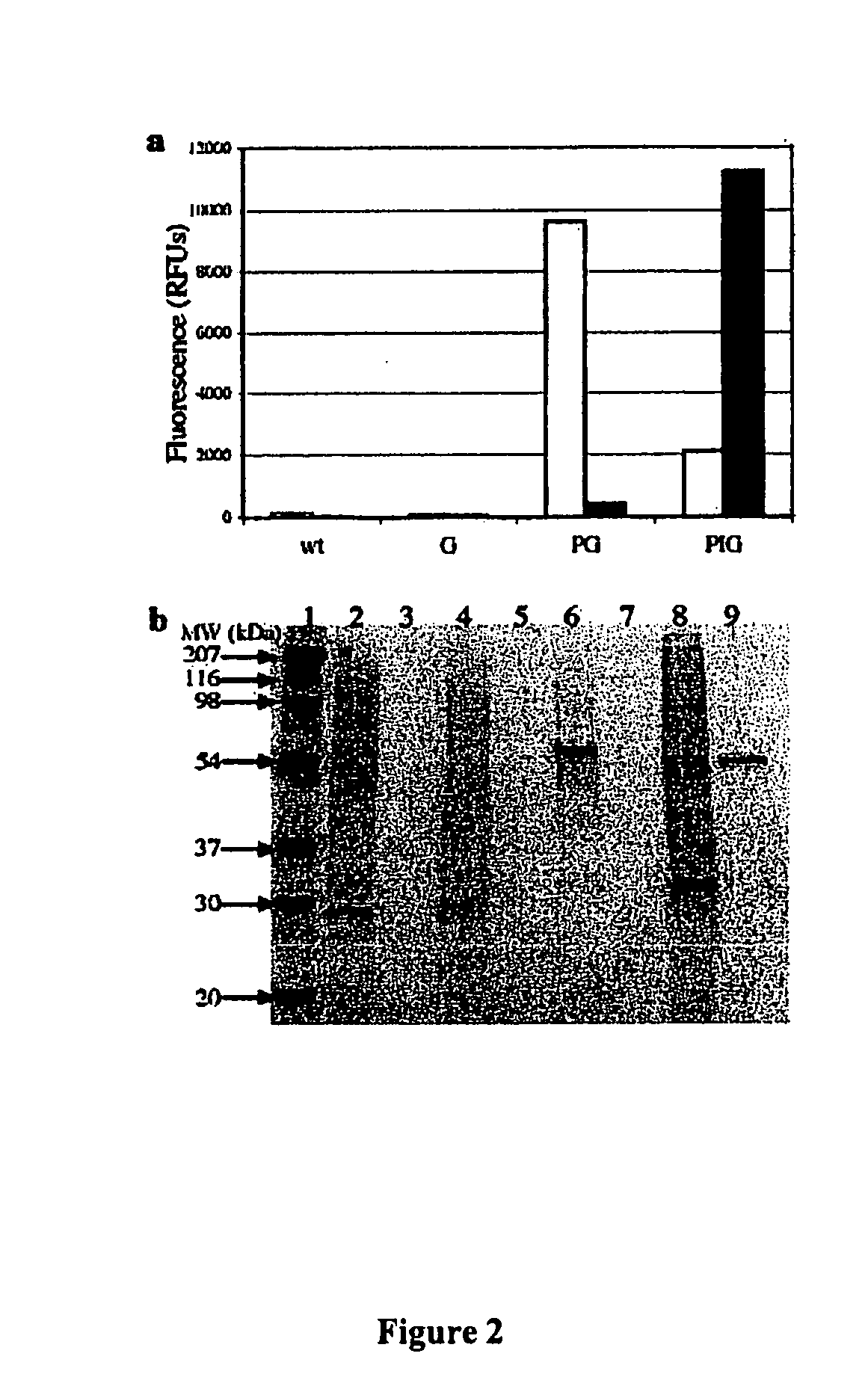Intein-mediated protein purification using in vivo expression of an aggregator protein
a technology of aggregator protein and purification method, which is applied in the field of purification of recombinant proteins, can solve the problems of reducing the final yield of the product, reducing the efficiency of downstream purification, and wasting time, and achieves high through-put screening, high automation, and improved plasmid functionality.
- Summary
- Abstract
- Description
- Claims
- Application Information
AI Technical Summary
Benefits of technology
Problems solved by technology
Method used
Image
Examples
example 1
A General Purification Scheme Using PHBs
Introduction
[0054] We describe here a protein purification scheme in which the cell produces its own “biological affinity matrix,” thereby eliminating the need for external chromatographic protein purification. This approach is based on the specific interaction of phasin proteins with granules of PHB.
Comparison with Conventional Affinity Separation
[0055] An embodiment of the method of the invention can be compared to conventional means of affinity-based protein purification. See FIG. 1. FIG. 1A illustrates conventional affinity-based protein purification: Cells containing a plasmid for expression of the affinity tag-product protein fusion are induced and harvested. The cell pellet is resuspended, lysed and passed over an affinity resin (1A). The column is then washed to rinse away impurities (2A). The fusion protein is retrieved from the column by addition of excess affinity tag or a displacing substitute. Furthermore, a protease is typi...
example 2
PHB Purification of GFP
Introduction
[0057] By creating in-frame fusions of phasins and green fluorescent protein (GFP) as a model protein, we discovered that GFP can be efficiently sequestered to the surface of PHB granules. In a second step, we generated a phasin-intein-GFP fusion in which the self-cleaving intein was activated by the addition of thiol. This construct allowed for the controlled expression, binding and release of essentially pure GFP in a single separation step.
[0058] A protein expression platform based on the Gram-negative bacterium, Ralstonia eutropha is a useful alternative to recombinant protein expression in Escherichia coli.
[0059] This example uses the natural ability of R. eutropha to produce PHB, which accumulates as insoluble granules within the cell.
[0060] Phasins encoded by the phaP gene (SEQ ID NO:4) accumulate during PHB synthesis, bind to PHB granules and promote further PHB synthesis. Some deletion mutants of phaP form only one large PHB granule....
example 3
Materials and Methods for E. coli-Based Expression
Bacterial Strains, Constructs, and Standard Genetic Manipulations
[0076]E. coli strains XL1-Blue (recA1 endA1 gyrA96 thi-1 hsdR17 supE44 relA1 lac [F′ proAB lac1qZΔM15 Tn10(TetR)]) from Stratagene (La Jolla, Calif.), ER2566 (F−lamda−fhuA2 [Ion] ompT lacZ::T7 gene1 gal sulA11 D(mcrC-mrr)114::IS10 R(mcr-73::miniTn10—TetS)2 R(zgb-210::Tn10)(TetS) endA1 [dcm]) from NEB (Beverly, Mass.), BL21 (DE3) (F−ompT hsdISB (rB−mB−) gal dcm(DE3)) and BLR (DE3) (F− ompT hsdSB (rB−mB−) gal dcm (DE3) Δ(srl-recA)306::Tn10 (TetR)) from Novagen (Madison, Wis.) were used for cloning and expression using standard techniques Sambrook and Russell, Molecular cloning: a laboratory manual, 3rd ed., Cold Spring Harbor Laboratory Press, Cold Spring Harbor, N.Y., 2001. Plasmids pJM9131 (KanR) containing the phaCAB operon for PHB biosynthesis and phaK (CamR) containing the phasin phaP gene were kindly provided by Professor Douglas Dennis (Arizona State University,...
PUM
| Property | Measurement | Unit |
|---|---|---|
| Temperature | aaaaa | aaaaa |
| Flexibility | aaaaa | aaaaa |
| Strain point | aaaaa | aaaaa |
Abstract
Description
Claims
Application Information
 Login to View More
Login to View More - R&D
- Intellectual Property
- Life Sciences
- Materials
- Tech Scout
- Unparalleled Data Quality
- Higher Quality Content
- 60% Fewer Hallucinations
Browse by: Latest US Patents, China's latest patents, Technical Efficacy Thesaurus, Application Domain, Technology Topic, Popular Technical Reports.
© 2025 PatSnap. All rights reserved.Legal|Privacy policy|Modern Slavery Act Transparency Statement|Sitemap|About US| Contact US: help@patsnap.com



